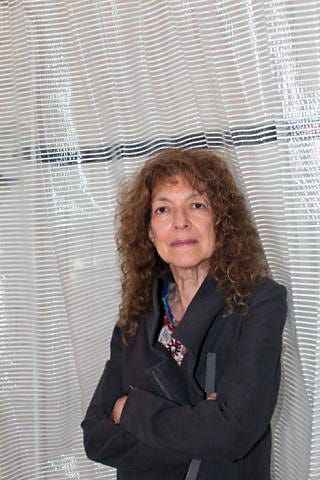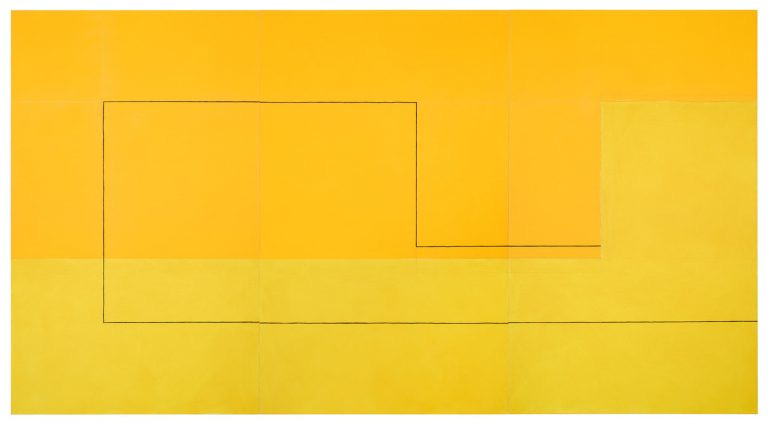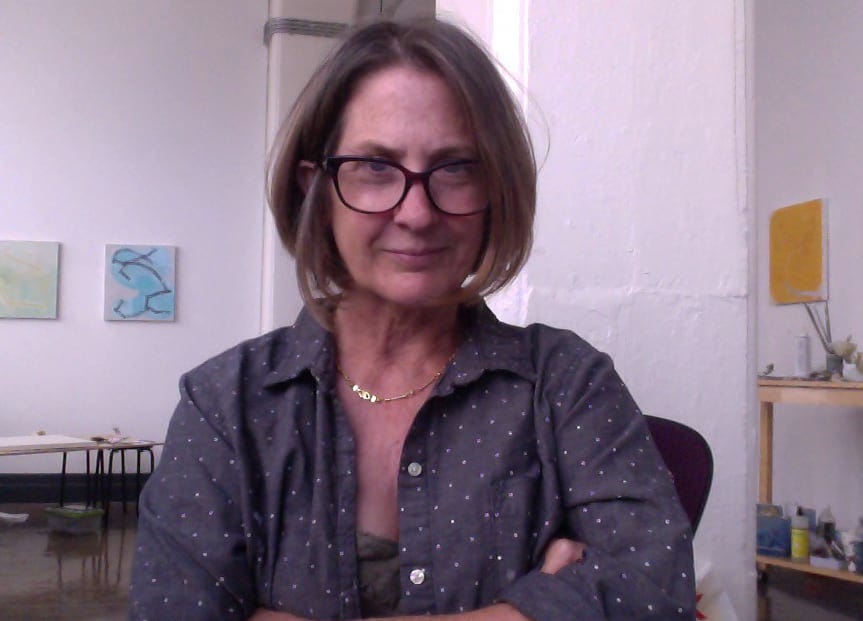If you’re like me, you may be finding it hard to pay heed to anything other than the unfolding horrors in our nation’s capital. I know a few who are able to tune out the news completely, but I’m like the driver who can’t resist slowing down to take in the details of the car wreck ahead of me. How bad is it? Is there blood on the road? Will there be survivors?
In terms of the national psyche, since the outbreak of COVID-19 in late 2019, it feels like we have been on a teeth-gritting rollercoaster ride—first though lockdown, then the relative calm of the Biden years, and now heading full-tilt boogie into the wild blue yonder. Yikes!
Art is not quite the last thing on my mind—I do glance at the online bulletins from ARTnews, Artnet, and Hyperallergic. But I spend more time reading three Substacks to make sense of the news, each excellent in its own way: Heather Cox Richardson’s Letters from an American, Robert Hubbell’s The Hubbell Report, and Jessica Craven’s Carry Water, Chop Wood. The last is especially helpful if you want to register your dismay with our lawmakers, as she includes links to your representatives in Congress and sample scripts for you to read or cut and paste into an email. And these are having an effect: As Hubbell reported, “Democrats in Congress are beginning to get the message, largely because they are being flooded with outraged calls from their constituents.” It only takes a few minutes of your time to reach out and bug someone. So just do it.
Nonetheless, art, in one form or another, has been my vocation and my passion for more than 30 years, and I’m enjoying the resuscitation of old posts from Vasari21.com on Substack. In two recent newsletters, here and here, we polled critics on their methods and motivations in writing about art. But the real issue for many working artists is how to get a critic or reviewer to pay attention in the first place. It’s the dream of every artist to be noticed by a prestige critic, but if you are not with a blue-chip gallery or a name commodity in the art world, it’s a long shot, and one that could backfire, inspiring an out-and-out pan (yet, as Oscar Wilde remarked, “The only thing worse than being talked about, is not being talked about”). With the right moves and much patience, you can woo writers into your lair for a studio visit or spark enough interest to follow you. Herewith six writers, four of them also dedicated artists, offer their advice:
Kim Levin: How to get a critic to pay attention to your work? Different people go about things differently, and what works for one artist may not work for another. Chance plays a large part. Serendipity. Luck. Do something you are comfortable with.
It was a very different world in the years I was making studio visits: people answered phones and sent letters and postcards in the 1980s; they sent faxes in the ‘90s.
I once got a phone call from an artist who had just moved to New York. He quoted something I wrote and we discussed it and I ended up making a studio visit to see his work.
On the other hand, I once got a phone call at 1 a.m. on a Saturday from a quite drunk artist, well-known in the Pattern and Decoration movement. He said: “You called my work ‘decorative.’ What the hell did you mean by that?”
Another time, I got a call from Richard Prince, who demanded to know why I had referred to the work of Sherrie Levine as “re-photography.” He claimed to own the word “re-photography.” He told me: “That is my word,” a ridiculous claim from an artist known for his appropriation art. Another artist sent me a cow’s tongue as an announcement for a show, which, since I was traveling, sat in the hall rotting and almost got me evicted. Not the best idea. It’s impossible to forget things like that. So my first advice is to be polite: Don’t hand out announcements for your show at other artist’s openings or in elevators. Don’t bombard a critic for years with news of your art if no interest has been shown in it.
And last, but not least, start by reading as many different critics as you can. Pick a few whose work aligns with yours, whose writing deals with the same issues, whether in form or content or context—critics you feel some affinity with, or whose writing you relate to. And then, especially if you have an exhibition or a work on view, or if they have written something you appreciate, send a handwritten note and invitation with the information and, above all, with images. Or, since we’ve all become digital creatures now, send it by e-mail with a link.
Kim Levin is a former critic for The Village Voice and ARTnews. Her essays are in exhibition catalogues, as well as collected in Elsewhere: The Tainted Garden and Other Essays on Art, Life, and the Anthropocene (2020).
Franklin Einspruch: Before speaking to how to get a critic to pay attention to your work, let’s ponder whether and why. The days of the influential critic are over. They were the product of a much smaller art world, in a time before the periodicals were eviscerated. It was also a time when fine art was a common cultural touchstone. Williams College art historian Michael J. Lewis dates the beginning of the end to 1990, when the American public, prompted by the hearings around the NEA Four, “drew the fatal conclusion that contemporary art had nothing to offer them. Fatal, because the moment the public disengages itself collectively from art, even to refrain from criticizing it, art becomes irrelevant.”
If you merely want to be written about, target the art reporters rather than the art critics. The former are more numerous, and they have more opportunities to write. (Obviously, the critics and the reporters are often the same people.) The feature writer’s main need is what we scriveners call an “angle.” Some poor sap has to convince his editor to let him turn your story into 800 words of copy. If you’re not sure what your story is, enlist the services of an arts marketer to help you form one. Without it, your press release—the next step—is sunk. A certain kind of person can make art with the press release in mind. Whether and to what degree that is appropriate is an exercise left to the reader. I’ll say, though, that as a critic, I can smell a lack of integrity like a Rottweiler can smell fear.
If your goal is not merely to be written about, but to have a genuine creative and intellectual exchange with someone whose judgment you respect, you need only approach the critic with the regard and good faith that you would like the critic to approach you. I do a fair number of studio visits, some of which I arrange, some of which the artists arrange. I often accept offers from artists to meet them at their shows, if they have one up. This goes better if the artist has some idea of where I’m coming from as a critic, but not too much of one, because my tastes are unpredictable and I may surprise you.
Also, your goal should not be to get me to review your current show or your current body of work, but to see it in preparation for your next one, or the one after. I may indeed write about the current one, but time and opportunity often run short. Rather, the idea is that we form some mutual knowledge and respect over a stretch of time, and then our work lives cross one day and I’m available to review your show or write your catalogue or curate you into an exhibition or whatever it is, and I can put something together because I have a sense of your trajectory.
You may not care to bother with any of this. If not, I wouldn’t blame you, and you should just keep making your art. I can’t promise to do anything for you, even if I try. But if I look at your art I will see it to the utter extent of my power to see anything.
Franklin Einspruch is an artist and the editor of the now-defunct but ambitious Delicious Line, as well as Aphorisms for Artists: 100 Ways Toward Better Art by Walter Darby Bannard (Allworth Press, 2024) He also contributes regularly to The New Criterion.
Karen Wilkin: In my experience, an introduction from someone the critic knows and respects makes all the difference. Like many other things, the personal connection is invaluable. I try to see group shows organized or juried by people whose eyes I trust, where I sometimes make discoveries, but in the interest of self-preservation, I ignore unsolicited or unsupported requests that I see shows or otherwise pay attention. When an artist I’m interested in suggests something, I respond to that, sometimes to my benefit. I’m involved with Triangle Arts Association, a highly competitive residency program for international artists that often introduces me to artists new to me. Robert Taplin, whose work and writing I’ve followed for years, with enthusiasm, once suggested I see a show by Jan Cunningham, a painter whose work I didn’t know. Turns out she makes subtle, inventively colored geometric abstractions that play different kinds of drawing against the memory of a grid. I’m very grateful to Robert for alerting me to her work and I hope to see more in the future. Other occasions have been less rewarding, such as when I prepared for a discussion of assigned exhibitions by trekking to a gallery in the wilds of Brooklyn, open only on weekends (probably only when the wind is from the southeast), to see a pretentious installation by someone I was unfamiliar with and hope to remain unfamiliar with. Luckily, I didn’t have to meet him.
Karen Wilkin is a New York-based critic, curator, and teacher, who writes regularly for The Wall Street Journal, The Hudson Review, and The New Criterion.
David S. Rubin: For me, “a picture is worth a thousand words” has always worked at getting my attention. There was a time when, as a curator and critic, I would save illustrated exhibition mailers and organize them into thematic file folders. Now that we live in the digital age, I think an actual mail piece might stand out and garner a curator’s or critic’s attention. Today, of course, artists use email and social media such as Facebook and Instagram to get their work seen virtually. Email a link to your website along with an invitation to visit your studio. As with approaching a gallery, artists should target the writers they approach, so do your homework and seek out critics who have previously shown an interest the kind of work that you do. You might try friending them on Facebook or connecting on Linked-in if they have an account.. Yet to stand out from the mass emails that critics receive, look into self-publishing something about your work in hard copy. [Note that we will be covering this topic soon. A.L.] I recently visited the studio of an artist who found an inexpensive online printer and produced a low-cost but very nice-looking catalog on his work. See if you can get a mailing address and send something that your targeted writers can open in the mail and hold in their hands. If you have an exhibition on view, schedule a gallery talk and be sure to invite your targeted writers to attend.
David Rubin is a Los Angeles-based independent curator, artist, and writer. GET DEETS FROM PREVIOUS POST
Laurie Fendrich: Venues for art criticism, along with art critics, are rapidly disappearing from the landscape. Part of the problem stems from what Irving Sandler called the decline of art world “polemics”—i.e., critics arguing over the quality of art—and part from the rise of identity-based art. Artists still want attention for their art, however, and this requires self-promotion.
I’m a sometime art critic, as in, I mostly confine myself to essays about the role of art and artists in society. Even so, I write enough reviews to receive a stream of emails from artists, galleries, and museums that help me decide which shows I’d like to see in the flesh and possibly review. Sending them is tedious, but it remains the front line of attack for any artist wanting to get the attention of a critic.
Notwithstanding my own love/hate relationship with Instagram, given it’s the most popular social media platform for artists, and that critics use it as well, having a presence on it is de rigueur. Tagging admired critics and artists, “liking” posts, and making comments can lead to sales, exhibitions, and reviews. [We will have more about this too, shortly A.L.]
Or let’s just say that’s the hype. The reality is that Instagram is all about ephemera and can’t do much to get the attention of a critic. The ideal way to get a critic to pay attention is a face-to-face encounter, but here’s the rub: Not only can it be hard for artists to find a way to meet critics, approaching them directly isn’t like saying, “Hi, I find your writing smart and interesting and I’d like to know you better,” but rather, “Hi, you have power in the art world and I want you to sprinkle your pixie dust on me.” The transactional nature of it all is off-putting to anyone of sensibility, but most critics are forgiving. After all, critics want to be on top of what’s new. My advice is to attend openings and art panels, be as sociable as you can, and weasel your way into talking with any artists and critics you meet.
When I was a young(er) artist and had first moved to New York, I naively sent letters to three well-known critics: Clement Greenberg, Leo Steinberg, and Hilton Kramer. Greenberg and Steinberg were men with big egos in the fading days of their glory, and Kramer was a notoriously conservative and cranky art critic writing for The New Criterion who wrote only the occasional positive review that my artist friends mocked as “the kiss of death.” Greenberg visited my studio, drank a scotch, and told me I used too much value contrast. Steinberg had by then become quite infirm, but I ended up visiting him and having wonderful conversations with him. As for Kramer, he blessed me with one of his kiss-of-death reviews.
The lesson, if any: Practice self-promotion to the extent you aren’t obnoxious and never deform your art as you try to get attention. That way, no matter how Lady Luck treats you, you’ll be able to live with yourself.
Laurie Fendrich is an artist and writer based in Lakeville, CT. She taught for more than four decades, and has been a regular essayist and critic for The Chronicle Review and the website "Two Coats of Paint."
Sharon Butler: The best thing artists can do is read criticism and reviews. Too many artists want to have their shows reviewed, but never take the time to read criticism themselves. Through reading, artists will begin to understand what type of work each of the critics covers. Decide who is mostly likely to respond to your work and add them to your email list. If they are on Instagram, Twitter, or Facebook, follow them and comment on their posts. In short, start a conversation. Then, when you have a show, they might be more interested in seeing and writing about your work.
You can also raise your visibility by starting a project that creates opportunity for other artists and writers. Curate a show, do artist interviews for a local publication, start a salon. If you contribute in some way, people will be more interested in what you are doing, and, again, writers will be more interested in covering it.
But, most of all, make work that inspires discussion, opinion, argument. If you make the same boring thing year in and year out, no matter how well drawn or painted, there is nothing for critics to write about.
Sharon Butler is a New York-based painter and the founder and editor of Two Coats of Paint, a project that includes reviews, an artists’ residency, and interviews with artists.
The bottom line here is that you should get to know the critic as well as you would like the critic to know you (this is where Google, Facebook, LinkedIn, and Instagram are tops for research). And remember that we writers don’t mind being courted a bit. I recently suggested to a friend with a show in the works for this spring, who lives in Connecticut, that she pay train fare and spring for lunch to tempt a visit from a New York writer—such a modest outlay of funds is hardly a bribe. And you never know (I for one loved getting out of the city when time permitted.)
But one big caveat here: be wary of any “critic” who asks to be paid by you, the artist, for a review (a catalogue essay is another matter). Even if the fees for writers are miserly, and they generally are, it’s the publication that pays. Not you. You have enough on your plate.











Sound advice!
Thank you for your list of critic/writers and their advice.